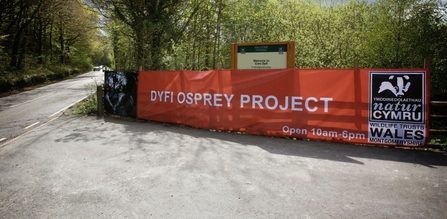In last week's blog we took a brief look at the first 10 years of DOP.
Let's now indulge in a bit of crystal balling and attempt to look forward to what the next decade may have in store for us.
February 2009 - the 'new visitor centre' arrives
In last week's blog we took a brief look at the first 10 years of DOP.
Let's now indulge in a bit of crystal balling and attempt to look forward to what the next decade may have in store for us.
February 2009 - the 'new visitor centre' arrives
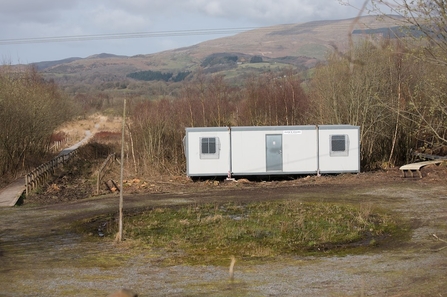
Future-proofing
In early 2009 we set up an osprey project with the best equipment we could afford and was available at the time. The iPad hadn't been invented yet, Instagram was over a year away from being launched and most people hadn't heard of HD let alone 4K. It's one thing making an osprey nest so strong that it will last many years into the future, it's no so easy future-proofing technology.
Yet in many ways, we find ourselves at this juncture again. As the 25-year old porta-cabin visitor centre nears the end of its life span, we need to future-proof its successor as much as we possibly can. But how?
A year ago we asked you to tell us what you would like to see in a new building at DOP. We asked you what you would like to see inside, how it should be constructed, what materials we should use, what information you would like to see inside, what events you would like us to host - and a load of other things. Over 1,400 of you completed the Survey Monkey research - a phenomenal consultation response - and I'm delighted to be able to give you an update 12-months later on how we are progressing.
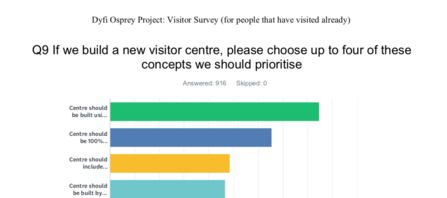
The Dyfi Wildlife Centre
Last June we heard we had been successful in securing Heritage Lottery Funding to develop a new centre at DOP. The centre itself will cost around £700,000 to build with the overall Dyfi Wildlife Centre Project costing a smidge over £1 million, including professional fees, planning fees, engineers, building regs, architectural fees, staff time, contingencies, IT, ramp access and decking, wheelchair lift, 10 acres of habitat management, lots of new tech, interpretation, displays, activity planning, evaluation, signage and car park improvements.
The Dyfi Wildlife Centre - will replace the current porta-cabins, cafe and toilets
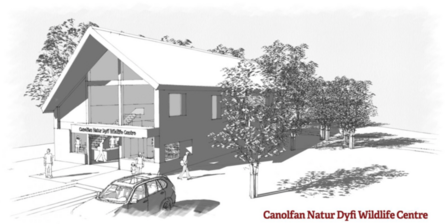
The Heritage Lottery Fund covers around 50% of the total project costs and in October we learned that we had been successful in securing £250,000 from a Welsh Government scheme called the 'Community Facilities Programme - "a capital grant scheme to improve community facilities which are useful to, and well used by, people in the community".
Last summer we launched a £250,000 Appeal to raise the remaining 25% 'match-funding' for the project. As I write this in early February, I can tell you that we have just passed the £85,000 mark; we're over a third of the way there already!
Thank you so much to all of you who have donated and/or set up your own fundraising projects.
In December just gone we heard back from our local planning authority - they have granted us full planning consent for the new Dyfi Wildlife Centre.
This is what the Planning Officer said:
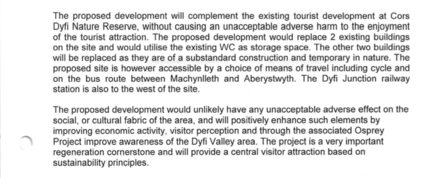
Consultation
In July last year we started the formal consultation process both at DOP in the 360 Observatory and amongst local communities. We wanted to know exactly what people wanted to get out of their new centre.
Community Consultation - Derwenlas
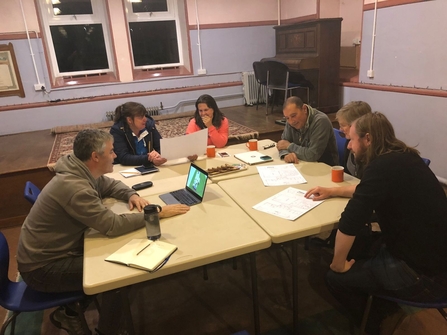
Some of the feedback we received matched very well with the 1,400 participant survey we had done a few months earlier. There were some surprises though, and we've taken most of these new ideas on board as well.
There are far too many to list, but here are 10 ideas/comments/suggestions we received during the year-long consultation that we will be incorporating into the new Dyfi Wildlife Centre:
1. Environmental Sustainability
You wanted us to build the new centre using the most environmentally friendly methods possible - so did we.
The centre has been designed using a timber post and beam construction - a building method that comprises vertical structural posts and horizontal beams, jointed to form a structural frame into which walls are ‘placed’. As this frame is structural, and carrying the roof load, the number of interior walls can be reduced, making it suitable for creating open plan spaces which we'll need. The walls will be timber too, with natural fibre insulation such as cellulose (recycled newspapers mushed up) and sheep's wool. We have plenty of that around here.
The timber will be locally grown Douglas Fir with local Dyfi cedar and larch as cladding. There really isn't a greener way to construct a building than this.
A Douglas Fir timber post and beam construction
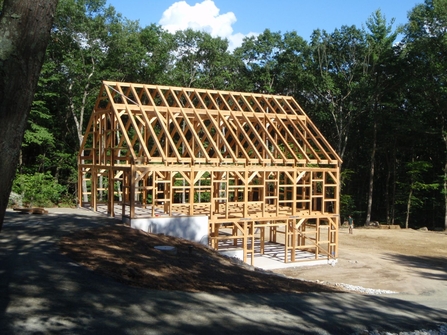
A full-solar roof array will generate around 5 megawatts of electricity per annum, enough to run around nine houses for a year, over and above what electricity we will use. Think of it as a small power station - a renewable clean one.
2. Ospreys
We have designed a specific area within the centre just for ospreys, with dimmed lighting.
Here you will be able to view (and hear) a minimum of four 55-inch OLED monitors showing live nest-camera action from the osprey nest. OLED screens represent the absolute pinnacle of current TV technology, they will be 4K resolution and they'll be amazing.
Another screen will look back at DOP all the way to the start in 2009 with stunning photographs and graphics of all the Dyfi birds and their histories.
Nora defends a young Ceulan in the nest from a crow attack in 2012
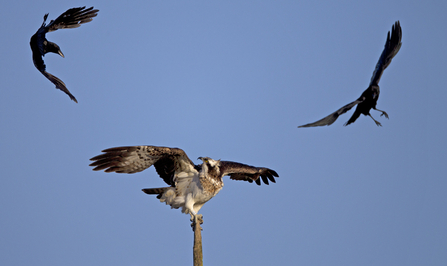
Nora. © MWT
In this area there will also be brand new osprey information panels as well as, of course, a volunteer or staff member permanently positioned to answer questions and explain what is going on in the nest at that time.
3. Opening
DOP is open for five to five and a half months of the year, usually late March to early September. You wanted us to be open for longer periods each year.
We will now open for eight months of the year instead of five: 1st March - 1st November. During the remaining four winter months we will still open for special events, half-terms etc. See below.
4. Other Wildlife
Many people commented that they wanted us to concentrate on other wildlife too and not just the ospreys. Now we will have the room, we can do just that.
Cors Dyfi Reserve has some amazing species right under our noses. Rare plants, moths, nesting warblers and owls - we can explain, interpret and showcase all of these and much more. Did someone mention beavers?
A Royal Fern growing next to the boardwalk by the 360 Observatory
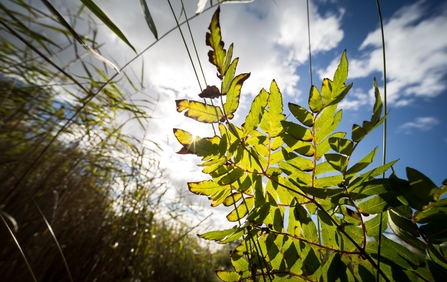
5. Build it Local, Local, Local
You wanted us to use local materials and contractors and we will. Our architect is Dafydd Tomos of George & Tomos based in Machynlleth - three miles from DOP.
Most of the materials we will use will also be sourced from the Dyfi area as will the actual contractors, the people that will build the centre for us.
Putting the final design elements in Dafydd's office just last week
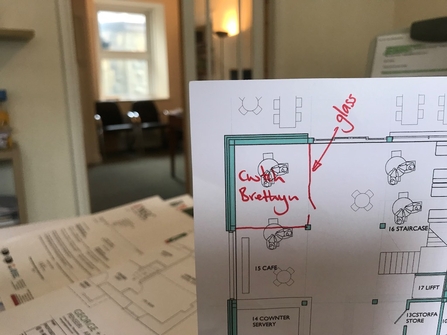
6. Local History
Many of you wanted us to focus on some of the Dyfi's amazing history. And we will.
We have broken the history aspect down into six themes based around one central topic hub, the Dyfi River itself.
We will weave all these themes into interesting talks, information panels and events and concentrate on how each one has, and continues to, affect the landscape and the wildlife we see today - including the ospreys.
The Dyfi River - A themed approach
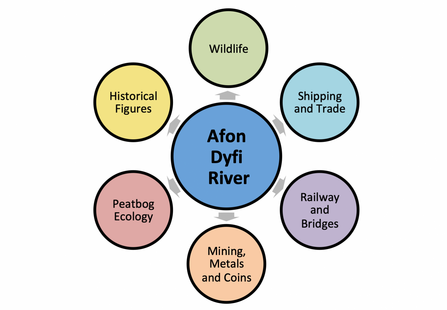
7. Disability and Access
Two people asked us over the last year whether we will have 'Changing Places Toilets'. I have to be honest, when I first heard of these I though they were baby-changing facilities. They're not.
A Changing Places toilet is a toilet specifically for people with profound and multiple learning disabilities - as well as other physical disabilities such as spinal injuries, muscular dystrophy and multiple sclerosis. These people often need extra equipment and space to allow them to use the toilets safely and comfortably. These needs are met by Changing Places toilets.
We have designed a Changing Places toilet into the Dyfi Wildlife Centre
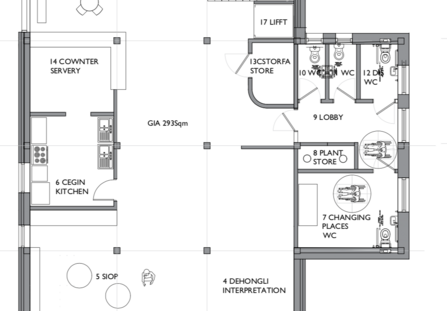
The extra room needed for a Changing Places toilet required us to build a separate autonomous toilet block rather than trying to squish everything inside the main centre throughway. This has added £40,000 - £50,000 to the overall costs which we'll need to find, but it will be worth it. This will only be the second public Changing Places toilet in mid Wales and will allow those people using it to go to the toilet with dignity and self-respect.
What's the point of building a centre for 99% of people?
8. Integrated Interpretation
Keeping as low a carbon footprint as possible and using recycled materials was a constant theme during the consultation. We will use reclaimed, re-purposed, recycled materials as much as possible; if it has a re- in front of it, we want to know.
There will be a strong climate change message in everything we do in the new centre and by utilising stuff that's been used before, we can re-enforce this message. So, for example, we will be on the look out for pallets to make pallet walls, secondhand timber tables and chairs for the cafe, old tins for wall coverings and reclaimed parquet blocks for the ground floor. There's no need to keep going back to mother earth for more if we can use what she has already given us.
A wall finish made out of old pallets; the volunteers are going to be busy...
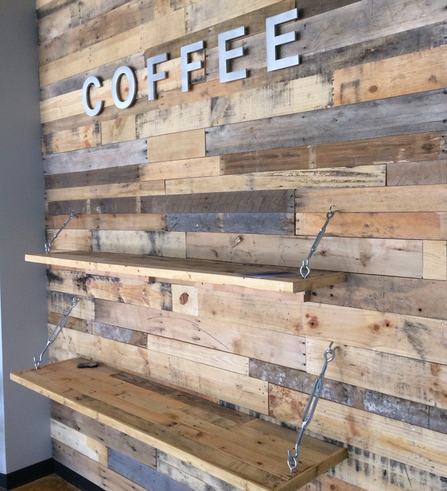
A local carpenter will build the main staircase in the new centre made out of reclaimed ship's oak if we can get it. The bannisters will be made out of reclaimed copper.
A bespoke, hand-made copper and oak staircase
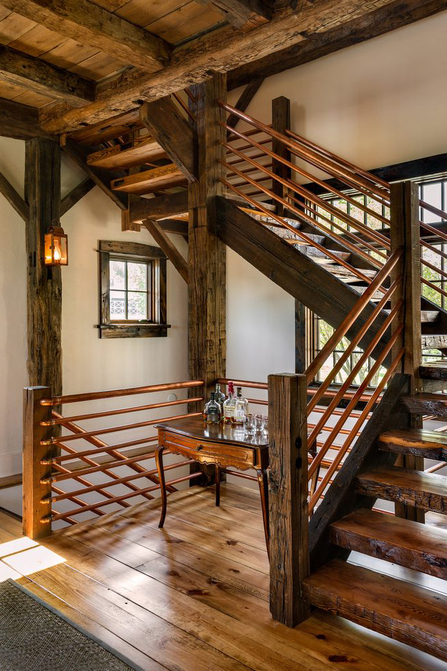
We will have information panels throughout the Dyfi Wildlife Centre explaining why the materials used in that area looks a bit unusual. This is what we mean by Integrated Interpretation.
9. Penny Floor
As many of you know, we will be using old pre-decimal coins in the building.
The original idea was to have small-scale projects (think penny tables), but the more old coins you donated to us, the grander our ideas became. We've ended up with one big massive floor project upstairs in the Galeri part of the centre which is 11 x 13m in total.
Now think of yourself in a hot air ballon high over the Dyfi River looking down. We will recreate the river in a coin mosaic as if you're looking down, starting off in Machynlleth, passing through Cors Dyfi and the osprey nest all the way out to Aberdyfi and Ynyslas where the estuary converges into the Irish Sea.
Here's a bit I've taken straight out of our DWC Interpretation Plan:
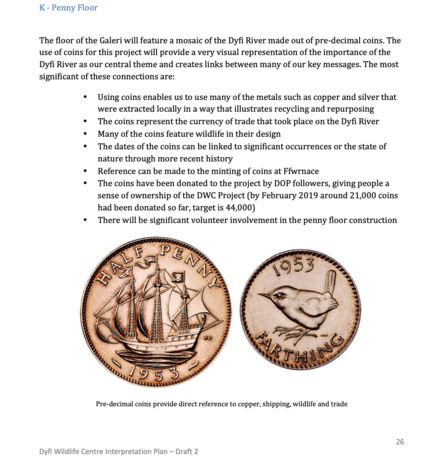
This will be the largest used coin mosaic in the world as far as I can tell. Keep those coins coming in, we're around half way there.
Some of the 21,000 coins you've already donated. We'll use silver coins for the river, copper ones for the banks (pun intended)
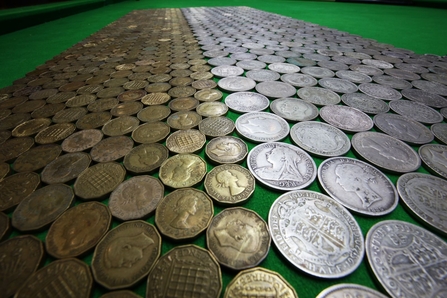
10. DOP and Context
Many of you commented that you liked the maps and information we put out in the 360 Observatory and boardwalks and would like to see the same happening in the new centre, but on a larger and wider scale.
How does DOP fit in within the context of the Dyfi River and Cors Dyfi Reserve as a whole, how close are things to each other, how far does Monty fly to catch fish, where are there other osprey nests in Wales, what other species are there in the area, what other nature reserves are there around, what is the Dyfi Biosphere?
Close to the osprey specific area of the new centre we'll have a massive 86-inch screen. It will be an interactive touchscreen - think of Google Earth on a huge scale that you can touch, designed specifically for DOP. We will reach out to IT software students and ask them to build a bespoke system just for us.
A Dell 86-inch 4K interactive touchscreen

Any Problems?
Consultation is never a one-way street. People have legitimate concerns too, as well as ideas and comments that will enhance the project.
To be fair, there weren't that many, two really. Here they are:
1. Habitat Loss - you'll be destroying the reserve
No, not really. We've taken huge measures to mitigating the effects of any potential habitat loss. Firstly, the centre will be built on the area vacated by removing the two porta-cabins that are there now, and the additional area we need is just hard standing and some scrub - we are not into the reserve proper here.
Area where the new centre will be built - scrub, hard-standing and current porta-cabins
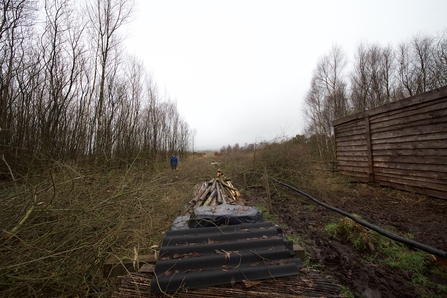
Even though we didn't need to, last year we employed external independent ecologists to come in and extensively survey the area for rare or protected species - they didn't find any. They did find bats in the toilet block - but we knew about them - they're roosting in the bat boxes we put up for them!
In any case, the old toilet block is staying and will be repurposed as a conservation tool store.
In terms of total area, the new centre will have a footprint of around 400m2 including decking and disabled ramp access. The total area of Cors Dyfi reserve is 136 acres, or according to Google Earth, 551,000m2. The new centre will take up 0.0007% of the reserve.
Cors Dyfi Reserve in yellow - Dyfi Wildlife Centre footprint in red:
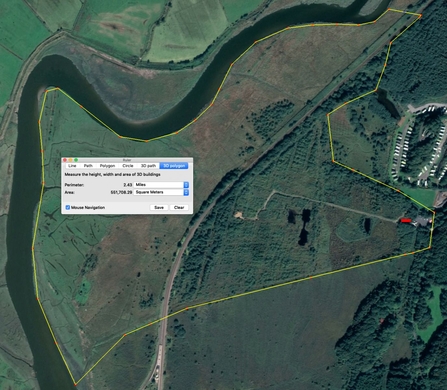
Finally, the Dyfi Wildlife Centre will be built on a foundation of stilts so we won't be pouring free-flowing concrete into the ground. The floor level will be around 1m off ground level so that any wildlife - small mammals, lizards etc, can move freely underneath.
2. It won't be the same - you'll lose that DOP community feeling
We've heard the "If it ain't broke, don't fix it' comment a few times over the last 12 months. Well, I'm afraid it is broke.
Have a look at this short video I took a few days ago - the last volunteer work party we had.
Two things stand out - it is far too small for the volunteers we have and there's water dripping in everywhere. This is not a new thing - it happens every winter and it costs a lot of money to fix. Kim's desk was where the buckets are - she now works, as do Janine and I, from home in the winter - it's too cold and damp in the porta-cabin and there's no running water - there's another pun for you.
We also run the online shop from a spare bedroom in my house, it's a lot of fun. Not.
Volunteer meeting - in the car park
There's no room for information panels, new technology, and what we have of the cabins left is falling apart. We can't take on any more volunteers, in fact we have a waiting list, and we can't take in more visitors. It's a common sight in the summer at busy times for cars to drive in and straight back out again due to a full and chaotic car park.
There are financial barriers too. The toilets cost £4,500 to empty every year and the total DOP maintenance costs per annum are close to £10,000 - we can't sustain this. The maintenance costs for the new centre will be a fraction of this, probably 10%, and that will be more than paid for by the feed-in-tariff for the electricity we export to the grid. We'll go from a £10k maintenance cost to nothing practically overnight - we can then invest this in things that you really want to see at DOP.
We had no planning permission either, it was rejected based on the current porta-cabins. It's either build a new fit-for-purpose centre or close down.
You need three things to run an osprey project: ospreys (although we've ran one without before!), a centre, and people. I would argue that the people are the most important of the three.
We have been very careful in designing every aspect of this project in such a way that we will not only keep that rather special community and friendly feel, but will enhance it. There will be more room, more volunteers and a brand new Galeri (Gallery) area upstairs to host events. Even Lowri will be in the new Caffi if she wants to - same 'old' faces, brand new centre.
We're not going to lose the friendly feel, we'll consolidate and build on it.
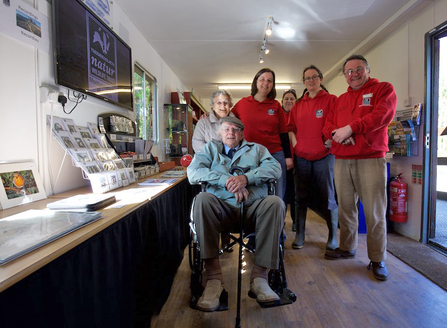
Changes can sometimes be difficult to adapt to - these will be changes for the better, I promise.
Wanna roww-aall?
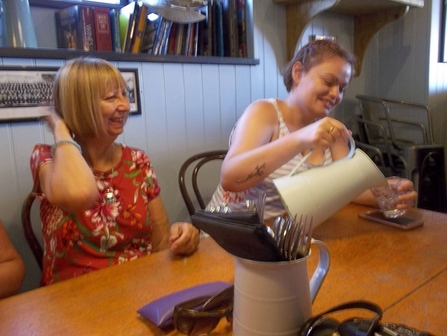
Timeframes
We will start work the day after DOP closes this summer at the end of August and will re-open in the new centre next year.
I'd love to tell you we'll be ready in time for the ospreys returning in 2020, but in reality, it will probably take longer than seven months to build the new centre. We'll still open on time in 2020 for the ospreys returning, but there may just have to be a Heath Robinson way of getting onto the reserve for a few weeks. The winter weather will play a role in all of this - we'll see.
When we do open, we'll be 95% ready, some of the projects I've mentioned above will take a bit longer. The coin floor project, for example, will take place during the winter months 2020-21 - there's several months work needed just for this.
Some of the 21,000 coins already donated - this is a big project
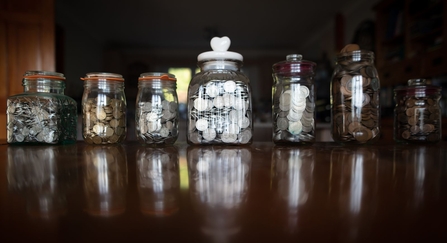
A New Frontier
So, that's it - you're up-to-date with all of the main headlines of the new Dyfi Wildlife Centre.
Most of our design and development work is done now and we can now concentrate on our ospreys returning - they'll be back in as little as six weeks.
This is our tenth year and 2019 promises to be a seminal year for DOP. After a decade of the project, for many the changes we'll see over the next year or so will be life-changing. I wanted to call this blog "The Greatest Show on Earth", partly after a Richard Dawkins book and partly because we're working really hard to make it be.
I thought the title too brash or arrogant to be honest, but that's what we're aiming for. Roll up, roll up, the show is almost ready to begin.
I'll keep you posted.
